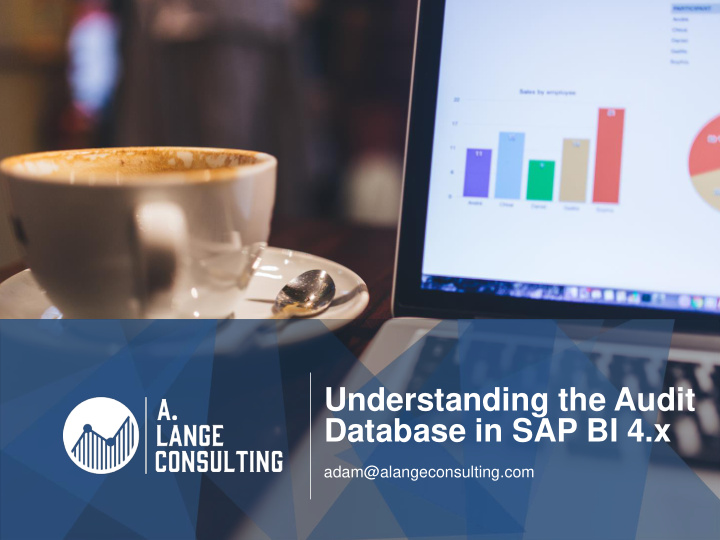



Understanding the Audit Database in SAP BI 4.x adam@alangeconsulting.com
RESOURCES http://help.sap.com/bobip42 See: Business Intelligence Platform Administrator Guide (Chapters 23 – 24) ADAM@ALANGECONSULTING.COM
SAP WEBINAR https://youtu.be/ll9G2JEWb9Q SAP Business Intelligence 4.2: New Auditing Universe and Reports ADAM@ALANGECONSULTING.COM
WHAT IS AUDITING? The SAP BI platform can record activity on the system, such as: – Which users are logging in and when? – Which reports are being run and by whom? – Who deleted an object? – Who is creating or modifying reports? – And so on… • Does not record system content, security, metadata ADAM@ALANGECONSULTING.COM
AUDIT ≠ CMS The audit database records activity. The CMS database records content and configurations. ADAM@ALANGECONSULTING.COM
ODBC Configure 32-bit and 64-bit ODBC connections to the audit database ADAM@ALANGECONSULTING.COM
AUDIT UNIVERSE Download auditing universe and reports (LCMBIAR files) and install via Promotion Management in CMC https://blogs.sap.com/2015/07/15/unlock-the-auditing-database- with-a-new-universe-and-web-intelligence-documents-for-bi41/ ADAM@ALANGECONSULTING.COM
AUDIT UNIVERSE Retrieve a list of Web Intelligence reports viewed (i.e. opened) since February 1, 2018. ADAM@ALANGECONSULTING.COM
AUDIT UNIVERSE List of users logged in since January 1, 2018. ADAM@ALANGECONSULTING.COM
AUDIT UNIVERSE List of users from the Finance Universe Group who have logged in since January 1, 2018. ADAM@ALANGECONSULTING.COM
AUDIT DATABASE TABLES * ADS_Event: Main log table ADS_Event_Type_Str: View, Delete, Logon, etc. ADS_Object_Type_Str: User, Web Intelligence, etc. ADS_User: Table of users and user names ADS_Event_Detail: Supplemental information about each transaction, e.g. universe name, user group * This is a partial list of tables in the Audit (ADS) database
AUDIT DATABASE TABLES * ADS_EVENT * This is a partial list of tables in the Audit (ADS) database
AUDIT DATABASE TABLES * ADS_EVENT_TYPE_STR ADS_EVENT * This is a partial list of tables in the Audit (ADS) database
AUDIT DATABASE TABLES * ADS_EVENT_TYPE_STR ADS_OBJECT_TYPE_STR ADS_EVENT * This is a partial list of tables in the Audit (ADS) database
AUDIT DATABASE TABLES * ADS_EVENT_TYPE_STR ADS_OBJECT_TYPE_STR ADS_EVENT ADS_USER * This is a partial list of tables in the Audit (ADS) database
AUDIT DATABASE TABLES * ADS_EVENT_TYPE_STR ADS_OBJECT_TYPE_STR ADS_EVENT ADS_USER ADS_EVENT_DETAIL * This is a partial list of tables in the Audit (ADS) database
AUDIT DATABASE TABLES * ADS_EVENT_TYPE_STR ADS_OBJECT_TYPE_STR ADS_EVENT_DETAIL ADS_EVENT _TYPE_STR ADS_USER ADS_EVENT_DETAIL * This is a partial list of tables in the Audit (ADS) database
AUDIT SQL EXAMPLES * SELECT E.User_Name, MAX(E.Start_Time) Most_Recent_Logon, COUNT(*) Logins FROM ADS_EVENT E INNER JOIN ADS_EVENT_TYPE_STR T ON E.Event_Type_ID = T.Event_Type_ID AND T.Language = 'EN' WHERE T.Event_Type_Name = 'Logon' AND E.User_Name <> '' AND E.User_Name IS NOT NULL AND E.Start_Time >= CONVERT(DATETIME,'11/01/2017',101) GROUP BY E.User_Name * Syntax applicable to SQL Anywhere
AUDIT SQL EXAMPLES * SELECT E.Object_ID, E.Object_Name Report_Name, FOLDER1.FOLDER_NAME + ISNULL(' > ' + FOLDER2.FOLDER_NAME, '') Folder, COUNT(*) Runs, COUNT(DISTINCT E.User_Name) Users, MAX(CAST(FLOOR(CAST(E.Start_Time AS FLOAT)) AS DATETIME)) Last_Opened FROM ADS_EVENT E INNER JOIN ADS_EVENT_TYPE_STR T ON E.Event_Type_ID = T.Event_Type_ID AND T.Language = 'EN' INNER JOIN ADS_OBJECT_TYPE_STR O ON E.Object_Type_ID = O.Object_Type_ID AND O.Language = 'EN' LEFT JOIN (SELECT F1.Object_ID, MAX(F1.Object_Name) FOLDER_NAME FROM ADS_EVENT F1 INNER JOIN ADS_OBJECT_TYPE_STR O1 ON F1.Object_Type_ID = O1.Object_Type_ID AND O1.Language = 'EN' WHERE O1.Object_Type_Name LIKE '%Folder%' GROUP BY F1.Object_ID) FOLDER1 ON E.Top_Folder_ID = FOLDER1.Object_ID LEFT JOIN (SELECT F1.Object_ID, MAX(F1.Object_Name) FOLDER_NAME FROM ADS_EVENT F1 INNER JOIN ADS_OBJECT_TYPE_STR O1 ON F1.Object_Type_ID = O1.Object_Type_ID AND O1.Language = 'EN' WHERE O1.Object_Type_Name LIKE '%Folder%' GROUP BY F1.Object_ID) FOLDER2 ON E.Folder_ID = FOLDER2.Object_ID WHERE O.Object_Type_Name = 'Web Intelligence' AND T.Event_Type_Name = 'View' GROUP BY E.Object_ID, E.Object_Name, FOLDER1.FOLDER_NAME + ISNULL(' > ' + FOLDER2.FOLDER_NAME, '') ORDER BY COUNT(*) DESC * Syntax applicable to SQL Anywhere
REPORT COMMENTARY Comments posted on Web Intelligence reports are stored in the Commentary_Master table ADAM@ALANGECONSULTING.COM
NEXT STEPS 1) Download and review BI Platform Admin Guide (Chapters 23 – 24) 2) Create 32-bit and 64-bit ODBC 3) Set auditing parameters in CMC 4) Install SAP auditing universe and sample reports ADAM@ALANGECONSULTING.COM
Q&A ADAM@ALANGECONSULTING.COM
Recommend
More recommend